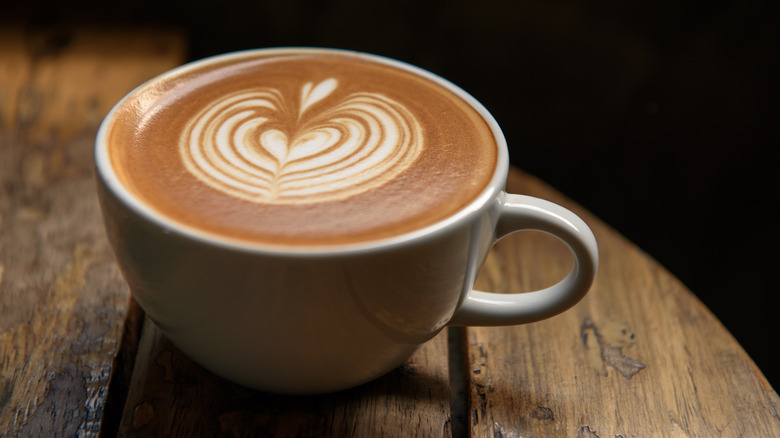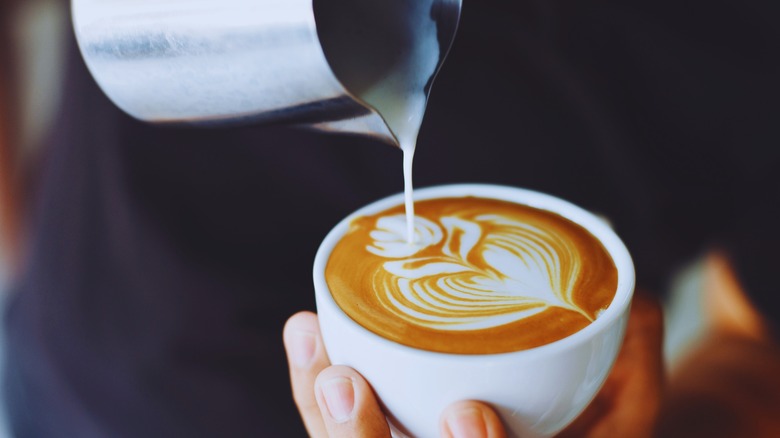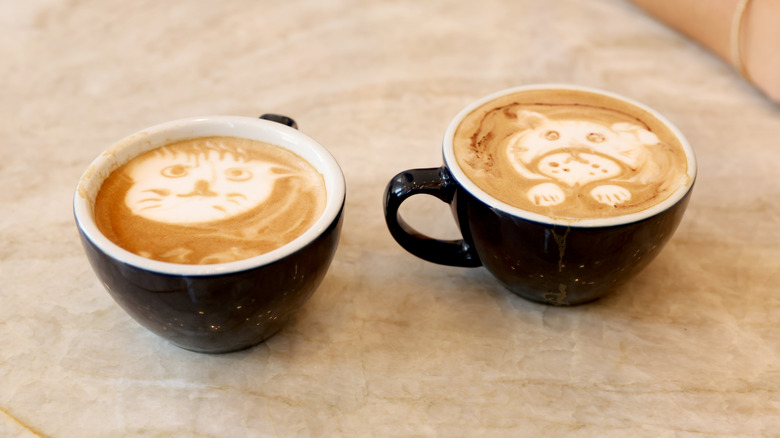Stunning Latte Art All Comes Down To The Type Of Milk You Use
In the age of social media, the premium on latte art has reached an all-time high. Back when people first started adding milk to coffee, they did so to balance the drink's harsh bitterness and acidity, but this practical purpose no longer suffices for us. Coffee is more than its functionality; it's a medium for artistic expression. There are Instagram accounts dedicated to latte art. Thousands of Pinterest posts show animals, plants, and even human portraits rendered in white foam. There's even a World Latte Art Championship, held every year since 2005.
With creative freedom, some baristas can produce such gorgeous imagery that drinking it out of existence almost seems sinful. How do they do it? More importantly, how can you start making your own latte art? Well, you'll have to practice, practice, practice, as you do with any skill, but before you even get to that point, you need to learn some of the science behind steaming milk.
Properly steamed milk is essential for making latte art. Over-steaming your milk can cause it to curdle, ruining your chances of getting light and airy foam. Over-steaming can also trigger a Maillard reaction in the milk, spoiling its flavor. Getting the steam time down just right can be a bit tricky because some types of milk take longer to steam than others. The difference really comes down to the two elements the milk is made of.
Latte art depends on the right combination of protein and fat
Perfect latte foam is all about steam time. Two factors affect steam time: Protein and fat. When milk is steamed, the proteins it contains change structure, unraveling and moving about. The loose protein strands capture air bubbles, stabilizing the structure of the foam. Fat does somewhat of the opposite; it does not capture air, loosening the foam structure. However, the fat in milk also contributes a rich flavor and a smoother foam texture. Stunning latte art is all about balancing the elements of protein and fat.
The effects of fat and protein on latte foam can clearly be seen by comparing whole and skim milk. Whole milk has a higher fat percentage (3.5%) than skim milk (less than 0.5%) but a lower protein percentage. Thus, high-protein skim milk captures larger air bubbles, creating a sturdier foam, while low-protein whole milk captures smaller bubbles, making foam with a thick, creamy texture.
Whole milk's higher fat content causes its foam to be quite creamy but less capable of holding its structure. The lower fat in skim milk makes its foam much sturdier, but it can become too stiff, making it incredibly difficult to pour. You can't make great latte art if the foam comes out in big blobs.
The best milk for latte art
Latte art comes down to the right balance of protein and fat; in this regard, whole cow's milk is the best option. It's the go-to milk for professional baristas and the standard on which lattes are built. Whole milk has just the right proportions of fat and protein to create foam that holds its structure, but not too stiffly. Masters of latte art love that whole milk foam is easy to pour, giving them much more creative control and freedom.
If you don't drink cow's milk, you can still make great latte art, but you must consider additional factors. Plant-based milks typically have very low concentrations of protein and fat, making them a little tricker to work with. Oat milk is the best plant-based option, as it can be steamed and poured like cow's milk. Almond and soy milks are more challenging. You may need to add more air, and it's best to stick with simple designs when using them.
The ideal steam temperature for dairy milk is between 140 and 150 F. If it reaches 160, it will curdle. The optimal steaming temperature for plant-based milks can vary significantly depending on the source, but will generally fall between 130 and 160 F. Hit that sweet spot, and you should have a stable but easily pourable foam. Then, make a whole lot of coffee because it's time to practice, practice, practice that latte art.


